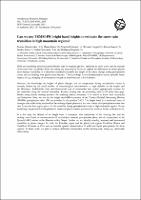Can we use TRMM-PR bright band heights to estimate the snow-rain transition in high mountain regions?
| dc.contributor.author | Schauwecker, Simone | |
| dc.contributor.author | Rohrer, Mario | |
| dc.contributor.author | Schwarb, Manfred | |
| dc.contributor.author | Huggel, Christian | |
| dc.contributor.author | Suarez, Wilson | |
| dc.contributor.author | Arias, Sandro | |
| dc.contributor.author | Salzmann, Nadine | |
| dc.contributor.author | Gurgiser, Wolfgang | |
| dc.date.accessioned | 2022-05-03T17:44:34Z | |
| dc.date.available | 2022-05-03T17:44:34Z | |
| dc.date.issued | 2015 | |
| dc.identifier.uri | https://hdl.handle.net/20.500.12542/2021 | |
| dc.description.abstract | Field and modelling based research indicates that for tropical glaciers, variations in snow cover and the altitude of the snow line via albedo effects are among the most crucial factors to explain the differences in annual glacier mass balance variability. It is therefore essential to identify the height of the phase change during precipitation events and its coupling with glacier mass balance. This knowledge is also fundamental to assess possible future impacts of e.g. changing air temperatures on glacier mass balances at low latitudes. However, the knowledge on heights of phase changes and air temperature during precipitation events is severely limited by the small number of meteorological measurements at high altitudes in the tropics and the Himalaya. Additionally, their one-dimensional type of observation that cannot appropriately account for the variations along the vertical dimension. Remote sensing data are promising tools to fill these data gaps. Before using remote sensing products for studying surface processes, it is crucial to know their accuracies and limitations. Here, we use the the bright band (BB) calulation of the Tropical Rainfall Measuring Mission (TRMM) precipitation radar (PR) as provided in the product 2A23. The bright band is a horizontal layer of stronger radar reflectivity produced by the melting of precipitation at the level where solid precipitation turns into rain. It may be thus a good proxy for the snowline during precipitation events at high mountain regions. To our knowledge, the potential of this product in studies of glacier surface processes has not been further evaluated so far. | es_PE |
| dc.format | application/pdf | es_PE |
| dc.language.iso | spa | es_PE |
| dc.publisher | American Geophysical Union | es_PE |
| dc.relation.uri | https://meetingorganizer.copernicus.org/EGU2015/EGU2015-4952.pdf | es_PE |
| dc.rights | info:eu-repo/semantics/openAccess | es_PE |
| dc.rights | Atribución-NoComercial-SinDerivadas 3.0 Estados Unidos de América | * |
| dc.rights.uri | http://creativecommons.org/licenses/by-nc-nd/3.0/us/ | * |
| dc.source | Repositorio Institucional - SENAMHI | es_PE |
| dc.source | Servicio Nacional de Meteorología e Hidrología del Perú | es_PE |
| dc.subject | Glaciares | es_PE |
| dc.subject | Glacier mass balance | es_PE |
| dc.title | Can we use TRMM-PR bright band heights to estimate the snow-rain transition in high mountain regions? | es_PE |
| dc.type | info:eu-repo/semantics/lecture | es_PE |
| dc.subject.ocde | https://purl.org/pe-repo/ocde/ford#1.05.11 | es_PE |
| dc.subject.sinia | precipitacion - Clima y Eventos Naturales | |
| dc.type.sinia | text/libro.presentacion | |
| dc.identifier.url | https://hdl.handle.net/20.500.12542/2021 |
Files in this item
This item appears in the following Collection(s)
-
Congreso [32]









